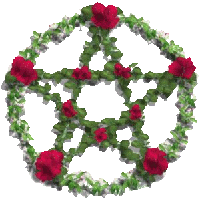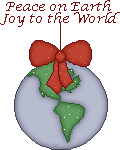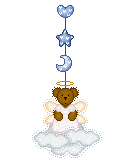|
How Yule became Christmas
The History from before Christ:

Origin of Yule
A celebration of the winter solstice has been held since time immemorial in the Northern Hemisphere. Throughout the ages the
festival has had many names. It is certain that a mid-winter festival called Yule was celebrated in the Nordic countries well
before the year 1000.
Though challenged by some scholars, the fact that Yule/Jól was celebrated here in Iceland and throughout the Northern Hemisphere
well before the advent of Christianity is now widely accepted. The exact date, or dates, that Yule was celebrated is not certain,
but it was probably connected to the full moon nearest the winter solstice. The calendar has been changed many times since,
and it is impossible to reconcile the references to an exact date.
The name itself has been retained in many languages--
Yule - Jól - Jul
even if the cause for celebration has shifted from the sun reversing its downward path, shining ever longer each day, to the
birth of Jesus. This linguistic retention of the name should be proof enough that the festival has always been an important
one. For close to a thousand years people have tried to explain the meaning of the name "Yule" to no avail. Some scholars
believe it comes from one of the names of Óđinn, others have even theorized that it came from the name of Julius Caesar. It
has also been suggested that Jól is derived from the Old-Nordic word for wheel: Hjól, the theory being that the wheel of the
year has come full circle, and this is just the tip of the iceberg. There have been more attempts at explanations than one
can shake a stick at. Certainly the exact meaning of the original word is something we shall never know.
This ancient festival is shrouded in mystery, but has left us a beautiful word describing a delightful occasion.
Good Yule - Gleđileg Jól

The Yule-Tree
Evergreen trees have always inspired awe and reverence in man. They seem to defy the winter with their verdure, even on the
darkest days of the year. No evergreen tree is native to Iceland, and the Rowan, European Mountain Ash, served as the tree
which was revered in Iceland.
The idea of the Yule tree was imported to Iceland in the middle of the last century, and the first recorded Yule tree was
a Rowan mentioned in 1862. Lights burned on its branches during Yule Eve and did not go out even when the wind was strong.
Obviously an outdoor Yule tree. Soon afterward, Yule trees, mainly home-made, started to become common in Iceland. These were
made from a central pole on which branches were nailed, long at the bottom and tapering as they neared the top. On these branches
the candles were fastened. The Yule tree was usually painted green, and native foliage was used to decorate it. Numerous,
coloured pouches were then hung on the Yule tree, often filled with candies which the children were allowed to eat after the
candles had burned out.
In this century, locally grown evergreens as well imported trees have replaced the home-made ones. Nowadays most Yule trees
in Iceland are locally grown. The tradition is to have a star or crown at the top, and to decorate the branches with light
bulbs and Yule decorations. The Icelandic Flag is also commonly used as a decoration. The Yule tree is usually decorated on
Ţorláksmessa or early on December 24th,
and somehow, magically, presents appear under the Yule tree on the night of Ţorláksmessa, and are added to during the morning
and afternoon of Yule Eve, as family and friends exchange Yule presents.

Yule Today
The Yuletide season today is very much a family affair. The family decorates the house and tree together and spends a great
deal of time at home. Family gatherings are a main feature of Icelandic Yule. The season consists of:
Ţorláksmessa - St. Thorlakur's Day - December 23rd
Iceland's major native Saint is heilagur Ţorlákur Ţórhallsson, or St. Thorlakur Thorhallsson, Bishop of Skálholt. He has two
days dedicated to him: December 23rd, which commemorates his death in 1193, and his other day, July 20th, which celebrates
the exhumation of his bones. The main custom associated with Ţorláksmessa is the partaking of a simple meal of skata or skate.
This custom, which originated in the West Fjords, has become traditional all over Iceland. The Yule tree is usually decorated
on this evening. This is also a big shopping day for last minute gifts, with stores remaining open until midnight.
Jól - Yule/Christmas
Celebrations start in Iceland at 6 p.m. on Christmas Eve, Yule Eve. This may have descended from the old days, when a new
day began not at midnight but at 6pm. Thus in Iceland there are thirteen rather than twelve days in the Yuletide season. There
are also many traditional stories and much seasonal folklore. The Jólasveinar or Yuletide Lads and their parents Grýla and
Leppalúđi are the most popular seasonal characters.
Traditional Yule food is Hangikjöt, smoked mutton. In times past a sheep was often slaughtered before the beginning of the
Yuletide season and a rich Kjötsúpa or mutton soup served. Another traditional delicacy, the Rjúpa or rock ptarmigan, started
out as the poor man's dinner but is now an expensive meal. Grautur, Porridge, on the other hand, was in past times a delicacy
in Iceland because of the scarcity of grain. Another Yuletide specialty is Laufabrauđ or leaf bread. This is very thin sheets
of dough cut into intricate patterns and fried.
Christmas gifts, Yule presents, were rare until late in the 19th century. Summer presents were much more common, though everyone
in the family received a new item of clothing either before or at Yule. The new clothing was a sort of bonus for work well
done. Tradition has it that those who did not receive a new garment would be captured by the Jólaköttur or yule cat.
Ađfangadagur - Christmas Eve/Yule Eve
Ađfangadagur is the day that all Icelandic children await impatiently, as after the evening meal they can open their Yule
presents. TV transmission stops in Iceland around 5 p.m. on Ađfangadagur and only restarts at 10 p.m. Usually the family listens
to Evensong on the radio then partakes of the evening's meal. Only then are presents opened and, according to the children,
the real Yule begins. It is usually the immediate family that spends Ađfangadagur together.
The Cathedral of Reykjavik
The family often attends Church together on Yule.
The Cathedral of Reykjavík.
Jóladagur - Christmas Day/Yule Day
Jóladagur is usually reserved for the extended family. Children gather at their parents home, and a feast, usually of Hangikjöt,
is eaten collectively. This is followed by cookies and iced cakes with whipped cream. The children bring their Yule presents
to the celebration and compare and play together.
Annar Jóladagur - Boxing Day
Yet another day of feasting, usually siblings or close friends visiting each other and partaking of even more sumptuous food
and pastry. (The period between Yule and New Year's is usually a time of recuperation in Iceland.)
Gamlárskvöld/Nýársdagur
New Year's Eve/New Year's Day
One of the most magical nights of the year is the night when the old year changes into the new. This night was also the eighth
night of Yule. Cows gain human speech, seals take on human form, the dead rise from their graves, and the Elves move house.
Hillfolk
Hillfolk by Elísabet Stacy-Hurley
A traditional greeting to the Elves was:
Let those who want to, arrive
Let those who want to, leave
Let those who want to, stay
Without harm to me or mine.
The housewife was supposed to chant this on New Year's Eve.
Elfin gold could be obtained from the Elves by sitting at a crossroads waiting for them to pass by.
Bonfires on New Year's Eve have been lit in Iceland since the late 18th century. In this century the custom of "sprengja út
áriđ", "blowing out the year" has been observed by detonating fireworks, and many families spend a small fortune on them.
It is usually a night of great merriment, with the family spending the first part of the evening together. However, dances
start a little before midnight and young people usually go to a dance.
Ţrettándinn - Twelfth Night - January 6th
The last day of Yule, celebrated in latter years with bonfires and Elfin dances. Many of the magical happenings associated
with New Year's Eve are also supposed to occur on Ţrettándinn.
|

